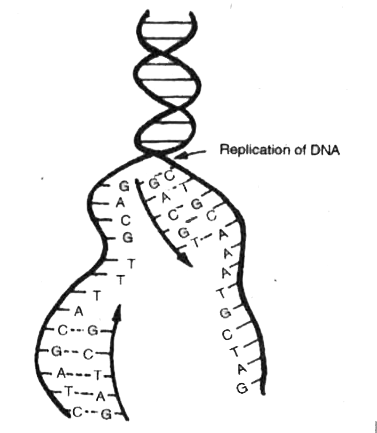How does DNA replicate ? Describe the mechanism of replication. How is the process responsible for preservation of heredity ?
Text Solution
1. Replication . It is the property of a molecule to synthesis another molecule. DNA has a unique property of duplicate or replicate itself i.e. it can bring about the synthesis of another DNA molecule. In this process, the two strands of DNA helix unwind and each strand serves as a template for the synthesis of a new strand. Due to unique specificity of base pairing, the newly synthesised complementary strand in each case is an exact copy of the original strand separated from it. As a result, two double stranded DNAmolecules are formed, one of the strand comes from the parent DNA molecule and the other is newly synthesised. Each DNA is exact replica of the parent. This is shown in Fig.
2. Process responsible for preservation of heredity. The double helix of DNA is the store house of the heredity information of the organism. This information is in the coded form as the sequence of bases along the polynucleotide chain. Since DNA has only four different bases, the genetic message can be compared to a language which has only four letters A, C, G and T.

|
Topper's Solved these Questions
- BIOMOLECULESBOOK - MBD -HARYANA BOARDCHAPTER - BIOMOLECULESEXERCISE - SHORT ANSWER TYPE QUESTIONS
26 Videos
- ALDEHYDES, KETONES AND CARBOXYLIC ACIDSBOOK - MBD -HARYANA BOARDCHAPTER - ALDEHYDES, KETONES AND CARBOXYLIC ACIDSEXERCISE - LONG ANSWER TYPE QUESTIONS
8 Videos
- BOARD QUESTION PAPER -2019 (SOLVED )BOOK - MBD -HARYANA BOARDCHAPTER - BOARD QUESTION PAPER -2019 (SOLVED )EXERCISE - LONG ANSWER TYPE QUESTIONS
6 Videos
Similar Questions
Knowledge Check
The process of DNA replication is :
AdispersiveBconservativeCsemiconservativeDnonconservativeIn eukaryotes , the process of DNA replication is :
ASemi - conservative and semi- discontinuousBContinuous and bidirectionalCSemi - conservative and continuousDBoth (A) and (B)[A]: Meselson and Stahl tested the Watson and Crick Theory of DNA replication.
[R]: They confirmed the mechanism of DNA replication by using the isotopic and Centrifu- gation techniqueAIf both A and R are true and R is the correct explanation of ABIf both A and R are true but R is not the correct explanation of ACIf A is true and R is falseDIf both A and R are false
Explain the process of DNA replication.
View Solution(a) Name the stage in the cell cycle where DNA replication occurs.
(b) Explain the mechanism of DNA replication. Highlight the role of enzymes in the process.
(c) Why is DNA replication said to be semiconservative ?
View Solution(a) Name the stage in the cell cycle where DNA replication occurs.
(b) Explain the mechanism of DNA replication. Highlight the role of enzymes in the process.
(c) Why is DNA replication said to be semiconservative ?
View SolutionIn eukaryotes , the process of DNA replication is :
View Solution[A]: Meselson and Stahl tested the Watson and Crick Theory of DNA replication.
[R]: They confirmed the mechanism of DNA replication by using the isotopic and Centrifu- gation technique
View Solution
